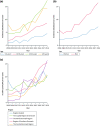Eosinophilic oesophagitis in Denmark: Population-based incidence and prevalence in a nationwide study from 2008 to 2018
- PMID: 36106558
- PMCID: PMC9486498
- DOI: 10.1002/ueg2.12273
Eosinophilic oesophagitis in Denmark: Population-based incidence and prevalence in a nationwide study from 2008 to 2018
Abstract
Background: Eosinophilic oesophagitis (EoE) is a chronic immune-mediated or antigen-mediated oesophageal disease characterised by symptoms related to oesophageal dysfunction and eosinophil-predominant inflammation.
Objective: We aimed to estimate the incidence and prevalence of EoE in Denmark during the period 2008-2018.
Methods: Based on data from nationwide registers we identified cases of EoE using two definitions: a broad definition based solely on oesophageal biopsies registered in the Danish Pathology Register and a narrow definition also including symptoms of oesophageal dysfunction registered in the Danish National Patient Registry. The annual incidence and prevalence were standardised by sex and age in 5-year intervals to the 2013 study population.
Results: From 2008 to 2011, the standardised incidence of EoE was stable, but from 2011 to 2018 it increased from 3.9 (95% CI 3.3-4.4) to 11.7 (95% CI 10.8-12.6) per 100,000 person-years. Similar temporal trends were observed when using the narrow EoE definition. The increase in incidence was most pronounced in men and in individuals above 40 years of age. In children, the EoE incidence was a fourth of the incidence in adults aged 40-64 years: 4.4 (95% CI 3.2-5.6) versus 17.6 (95% CI 15.7-19.5) per 100,000 person-years. The EoE incidence varied substantially across the five regions in Denmark. Overall, the biopsy rate as well as the proportion of oesophageal biopsies with detected eosinophilia increased during the study period.
Conclusion: This study of the entire population of Denmark during the period 2008 to 2018 shows that the incidence and prevalence of EoE is not yet plateauing and that EoE could be severely underdiagnosed, especially in children.
Keywords: eosinophilia; epidemiology; oesophagus; pathology.
© 2022 The Authors. United European Gastroenterology Journal published by Wiley Periodicals LLC on behalf of United European Gastroenterology.
Conflict of interest statement
The authors declare that there is no conflict of interest.
Figures




Comment in
-
Incidence and prevalence of eosinophilic oesophagitis: Are we reaching a plateau?United European Gastroenterol J. 2022 Sep;10(7):623-624. doi: 10.1002/ueg2.12282. Epub 2022 Aug 15. United European Gastroenterol J. 2022. PMID: 35971241 Free PMC article. No abstract available.
References
-
- Picus D, Frank PH. Eosinophilic esophagitis. AJR Am J Roentgenol. 1981;136(5):1001–3. - PubMed
-
- Attwood SE, Smyrk TC, Demeester TR, Jones JB. Esophageal eosinophilia with dysphagia. A distinct clinicopathologic syndrome. Dig Dis Sci. 1993;38(1):109–16. - PubMed
-
- Liacouras CA, Furuta GT, Hirano I, Atkins D, Attwood SE, Bonis PA, et al. Eosinophilic esophagitis: updated consensus recommendations for children and adults. J Allergy Clin Immunol. 2011;128(1):3–20. e6. - PubMed
-
- Furuta GT, Liacouras CA, Collins MH, Gupta SK, Justinich C, Putnam PE, et al. Eosinophilic esophagitis in children and adults: a systematic review and consensus recommendations for diagnosis and treatment. Gastroenterology. 2007;133(4):1342–63. - PubMed
Publication types
MeSH terms
Supplementary concepts
LinkOut - more resources
Full Text Sources
Medical

